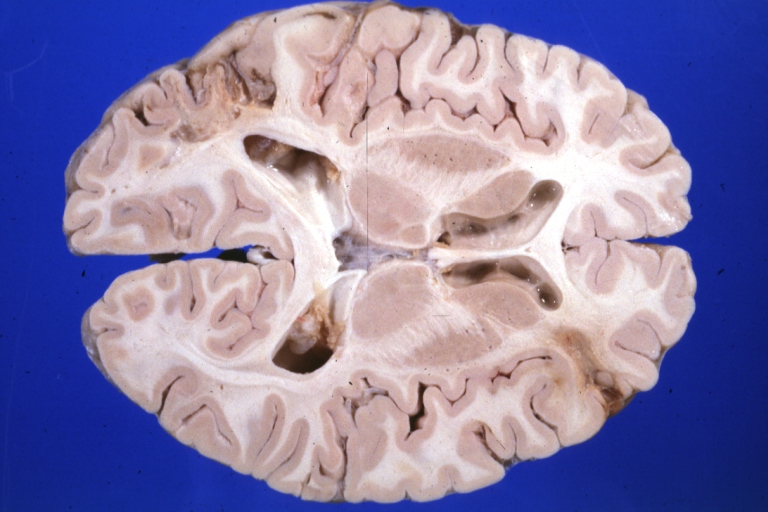Encephalopathy: Difference between revisions
Jump to navigation
Jump to search
Kiran Singh (talk | contribs) |
|||
| (60 intermediate revisions by 3 users not shown) | |||
| Line 1: | Line 1: | ||
__NOTOC__ | |||
{{Infobox_Disease | | {{Infobox_Disease | | ||
Name = {{PAGENAME}} | | Name = {{PAGENAME}} | | ||
Image = Encephalopathy 001.jpg| | Image = Encephalopathy 001.jpg| | ||
Caption = Binswangers Subcortical Encephalopathy: Gross fixed tissue horizontal section cerebral hemispheres at level of genu internal capsule <br> <small> [http://www.peir.net Image courtesy of Professor Peter Anderson DVM PhD and published with permission © PEIR, University of Alabama at Birmingham, Department of Pathology] </small>| | Caption = Binswangers Subcortical Encephalopathy: Gross fixed tissue horizontal section cerebral hemispheres at level of genu internal capsule <br> <small> [http://www.peir.net Image courtesy of Professor Peter Anderson DVM PhD and published with permission © PEIR, University of Alabama at Birmingham, Department of Pathology] </small>| | ||
}} | }} | ||
==Overview== | {{Encephalopathy}} | ||
{{CMG}} ; {{AE}} {{ADI}} | |||
== [[Encephalopathy overview|Overview]] == | |||
== [[Encephalopathy classification|Classification]] == | |||
== [[Encephalopathy pathophysiology|Pathophysiology]] == | |||
== | == [[Encephalopathy causes|Causes]] == | ||
== [[Encephalopathy differential diagnosis|Differential Diagnosis]] == | |||
== | == [[Encephalopathy risk factors|Risk Factors]] == | ||
== | == [[Encephalopathy natural history|Natural History, Complications and Prognosis]] == | ||
=== | == Diagnosis == | ||
[[Encephalopathy history and symptoms|History and Symptoms]] | [[Encephalopathy physical examination|Physical Examination]] | [[Encephalopathy laboratory tests|Laboratory Findings]] | [[Encephalopathy electrocardiogram|ECG]] | [[Encephalopathy electroencephalogram|EEG]] | [[Encephalopathy chest x ray|Chest X Ray]] |[[Encephalopathy CT|CT]] | [[Encephalopathy MRI|MRI]] | [[Encephalopathy echocardiography or ultrasound|Echocardiography or Ultrasound]] |[[Encephalopathy other imaging findings|Other Imaging Findings]] | [[Encephalopathy other diagnostic studies|Other Diagnostic Studies]] | |||
[[ | |||
== | == Treatment == | ||
[[Encephalopathy medical therapy|Medical therapy]] | [[Encephalopathy surgery|Surgery]] | [[Encephalopathy prevention|Prevention]] | [[Encephalopathy cost-effectiveness of therapy|Cost-effectiveness of Therapy]]| [[Encephalopathy future or investigational therapies|Future or Investigational Therapies]] | |||
== | == See also == | ||
* [[Brain damage]] | |||
*[[Brain damage | |||
{{CNS diseases of the nervous system}} | {{CNS diseases of the nervous system}} | ||
[[Category:Neurology]] | [[Category:Neurology]] | ||
| Line 80: | Line 47: | ||
[[Category:Greek loanwords]] | [[Category:Greek loanwords]] | ||
[[Category:Emergency medicine]] | [[Category:Emergency medicine]] | ||
[[Category: | [[Category:Intensive care medicine]] | ||
[[Category:Disease]] | |||
[[fr:Encéphalopathie]] | [[fr:Encéphalopathie]] | ||
[[pl:Encefalopatia]] | [[pl:Encefalopatia]] | ||
{{WikiDoc Help Menu}} | {{WikiDoc Help Menu}} | ||
{{WikiDoc Sources}} | {{WikiDoc Sources}} | ||
Latest revision as of 17:39, 4 June 2015
| Encephalopathy | |
 | |
|---|---|
| Binswangers Subcortical Encephalopathy: Gross fixed tissue horizontal section cerebral hemispheres at level of genu internal capsule Image courtesy of Professor Peter Anderson DVM PhD and published with permission © PEIR, University of Alabama at Birmingham, Department of Pathology |
|
Encephalopathy |
|
Diagnosis |
|---|
|
Treatment |
|
Encephalopathy On the Web |
|
American Roentgen Ray Society Images of Encephalopathy |
Editor-In-Chief: C. Michael Gibson, M.S., M.D. [1] ; Associate Editor(s)-in-Chief: Aditya Govindavarjhulla, M.B.B.S. [2]
Overview
Classification
Pathophysiology
Causes
Differential Diagnosis
Risk Factors
Natural History, Complications and Prognosis
Diagnosis
History and Symptoms | Physical Examination | Laboratory Findings | ECG | EEG | Chest X Ray |CT | MRI | Echocardiography or Ultrasound |Other Imaging Findings | Other Diagnostic Studies
Treatment
Medical therapy | Surgery | Prevention | Cost-effectiveness of Therapy| Future or Investigational Therapies
See also
Template:CNS diseases of the nervous system